MARIANI’S
September 4, 2005
NEWSLETTER
Taylor's
Automatic Refresher, San Francisco, 2005 Photo: Galina
Stepanoff-Dargery
UPDATE:
To
go to my web site, in which I will update food
&
travel information and help link readers to other first-rate travel
& food sites, click on: home page
ACCESS TO
ARCHIVE: Readers may now access
an
Archive of all past newsletters--each annotated--dating back to July,
2003, by simply clicking on www.johnmariani.com/archive
.
NEW
FEATURE! You may now subscribe anyone you wish
to this newsletter by
clicking here.
In
This Issue
Do You Know What It Means to New Orleans? by John Mariani
PRESERVING PARMA by Denise HarriganNEW YORK CORNER: -A City of Big Eaters of Every Kind by John Mariani
-Centrico by John Mariani
QUICK BYTES
~~~~~~~~~~~~~~~~~~~
KATRINA RELIEF BULLETIN BOARD
* From Sept. 6-10, Bonnell's in Ft Worth, TX, is offering a special Disaster Relief Menu. This menu costs $50 per person, and for each dinner sold, we will donate $25 to the American Red Cross. all 817.738.5489.
* On Sept. 12 Acadiana restaurant in DC will become the po' boy headquarters of a fundraising effort. Chefs Jeff Tunks, Robert Wiedmaier (Marcel's), Michel Richard (Citronelle), Roberto Donna (Galileo), Ris Lacoste (1789), Cesare Lanfranconi (Tosca), Frank Morales (Zola), Todd Gray (Equinox), Cathal Armstrong (Restaurant Eve), RJ Cooper (Vidalia), John Besh (August, New Orleans), Jeff Buben (Vidalia and Bistro Bis), Kevin Scott (New Orleans Bistro), John Wabeck (Firefly), et al, will make brown bag carry-out po' boys for a donation of $25 each, at 901 New York Avenue.Call Simone Rathlé for details and please contact us if you can get involved: (703) 534-8100, (703) 534-8102, or (800) 496-1733.
* On Oct. 5, restaurants across the country will band together in a "Dine for
*
On Oct. 17 Share
Our Strength
will host a Hurricane Katrina Relief Benefit with
40 top chefs from around the country for
a fundraising event, with 100% of the funds raised will go to local
organizations directly assisting victims in the areas affected by the
hurricane.
Each chef will prepare southern cuisine in tribute to the affected
region. Delta Airlines, Inc. will be donating tickets
to help bring in many of these chefs. For
event details and to purchase tickets, please go to www.strength.org.
DO
YOU KNOW WHAT IT MEANS TO MISS NEW ORLEANS?
by John Mariani
 Like
anyone with friends and fond memories of the Big Easy, I have
been
frustrated by a sense of loss and by not knowing where everyone is
and what is still standing. Most of my friends are all right,
having
gotten out of the city before Katrina hit, but none of them knows
what
happens next. Or when it will happen.
Like
anyone with friends and fond memories of the Big Easy, I have
been
frustrated by a sense of loss and by not knowing where everyone is
and what is still standing. Most of my friends are all right,
having
gotten out of the city before Katrina hit, but none of them knows
what
happens next. Or when it will happen.
There has been much brave talk about New
Orleans coming back
bigger and better than ever, but, despite my belief in the resilience
of its people, the devastation wrought causes me to know things will
never be the same. The water will be drained, the levees
strengthened,
and buildings will get built. People will move back in, unable to
stay
away from their beloved hometown, however compromised by Nature's
brutal
treatment of this beautiful place in a bend in the river.
Given the loss of human life and
personal property, it may seem ridiculous even to think about what
the city has lost in its
restaurant sector. Yet if any city on earth seems to revolve
around and
exist
for food, it was New Orleans, where the traditional greeting has long
been, "Where'd you have lunch, what'd you eat, and where you going for
dinner?" New Orleanians live, sleep, and breathe food and love
their
restaurants as much as the millions of visitors who came solely to eat
there, and it
is in the restaurants--from the posh places like Commander's Palace and
Brennan's to the beloved oyster houses like Acme and Ugelsich's--that
New
Orleanians played out their lives and loves, their joys and their
blues. No city has
ever had
a stronger, more indelible food culture, embracing French, African,
Native American, Italian, Portuguese, Spanish, and Asian traditions
that gave the word "gumbo" its special meaning, while the word
"lagniappe" came to symbolize the extra helping of hospitality New
Orleanians always give.
It was in New Orleans that the first
French restaurant outside of
New York--Antoine's--debuted, back in 1840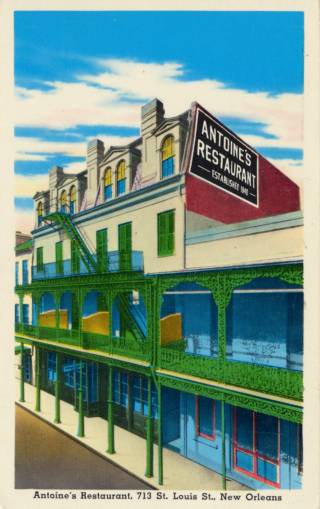 ; where Angelo Brocato
brought Italian ice cream long before anyone had heard of gelato;
where you could eat at Arnaud's with the city's swells and go upstairs
in see the Mardi Gras Museum; where bananas Foster was invented at
Brennan's and barbecued shrimp was cooked up at Pascal's Manale; at
Central Grocery the muffuletta was born, and people are always getting
into
arguments as to which eatery makes the best po' boys in town;
Ruth's
Chris Steak House started out here, and Paul Prudhomme sparked a mania
for Cajun food at K-Paul's Louisiana Kitchen; and who can forget
the
shrimp rémoulade at Galatoire's or the steaming beignets and
chicory
coffee at the Café du Monde? All these dishes, all this
flavor,
along
with a slew of indigenous cocktails, make New Orleans unique, so it's
impossible to believe it has all evanesced into the hot, humid air of
Louisiana.
; where Angelo Brocato
brought Italian ice cream long before anyone had heard of gelato;
where you could eat at Arnaud's with the city's swells and go upstairs
in see the Mardi Gras Museum; where bananas Foster was invented at
Brennan's and barbecued shrimp was cooked up at Pascal's Manale; at
Central Grocery the muffuletta was born, and people are always getting
into
arguments as to which eatery makes the best po' boys in town;
Ruth's
Chris Steak House started out here, and Paul Prudhomme sparked a mania
for Cajun food at K-Paul's Louisiana Kitchen; and who can forget
the
shrimp rémoulade at Galatoire's or the steaming beignets and
chicory
coffee at the Café du Monde? All these dishes, all this
flavor,
along
with a slew of indigenous cocktails, make New Orleans unique, so it's
impossible to believe it has all evanesced into the hot, humid air of
Louisiana.
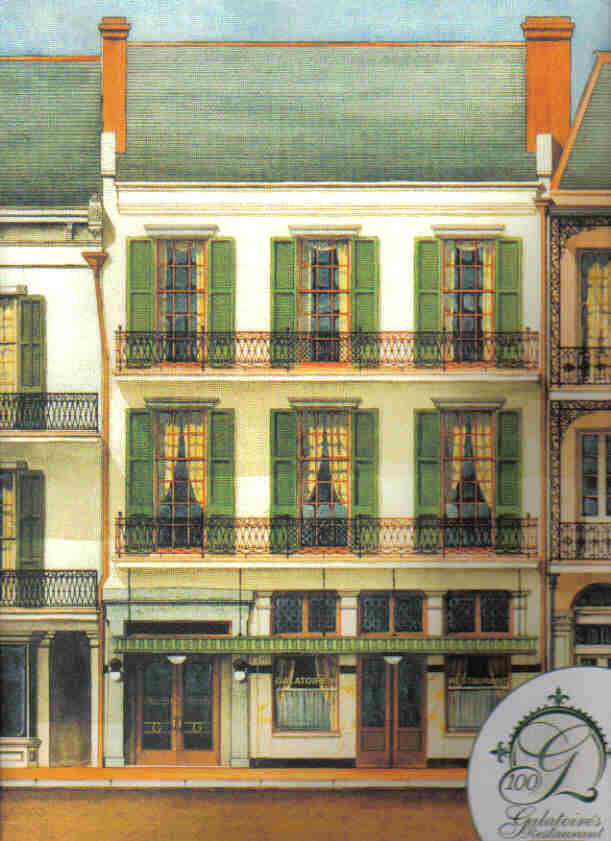 I suspect many of the old places will re-open and thrive
again,
though nothing will ever be quite the same. But because New
Orleans'
food culture will survive and because people will long for those dishes
and those restaurants, that bar stool near the window, that waiter at
Galatoire's (left), the
"day-bree" of roast beef shards that comes with
the po' boy at Mother's, and the arrival of Mardi Gras King's Cakes,
because of all that New Orleans will come back
to life. Just what it will look like, no one can imagine right
now.
But I think I know what it will smell and taste like. Just give
them
time to stoke the stoves, clean off the bar, and gather the first catch
of crawfish, crabs, and oysters. Right now, food is
sustenance to the
people in that drowned city. But before long, it will be life's
blood
again, giving strength to the people's indomitable spirit.
I suspect many of the old places will re-open and thrive
again,
though nothing will ever be quite the same. But because New
Orleans'
food culture will survive and because people will long for those dishes
and those restaurants, that bar stool near the window, that waiter at
Galatoire's (left), the
"day-bree" of roast beef shards that comes with
the po' boy at Mother's, and the arrival of Mardi Gras King's Cakes,
because of all that New Orleans will come back
to life. Just what it will look like, no one can imagine right
now.
But I think I know what it will smell and taste like. Just give
them
time to stoke the stoves, clean off the bar, and gather the first catch
of crawfish, crabs, and oysters. Right now, food is
sustenance to the
people in that drowned city. But before long, it will be life's
blood
again, giving strength to the people's indomitable spirit.
Right now, though, I can't help
but recall Louis Armstrong's melancholy song, which he and Billie
Holiday used to sing together, and how bittersweet and poignant its
lilting lyrics now sound:
"Do You Know What it Means to Miss
New Orleans"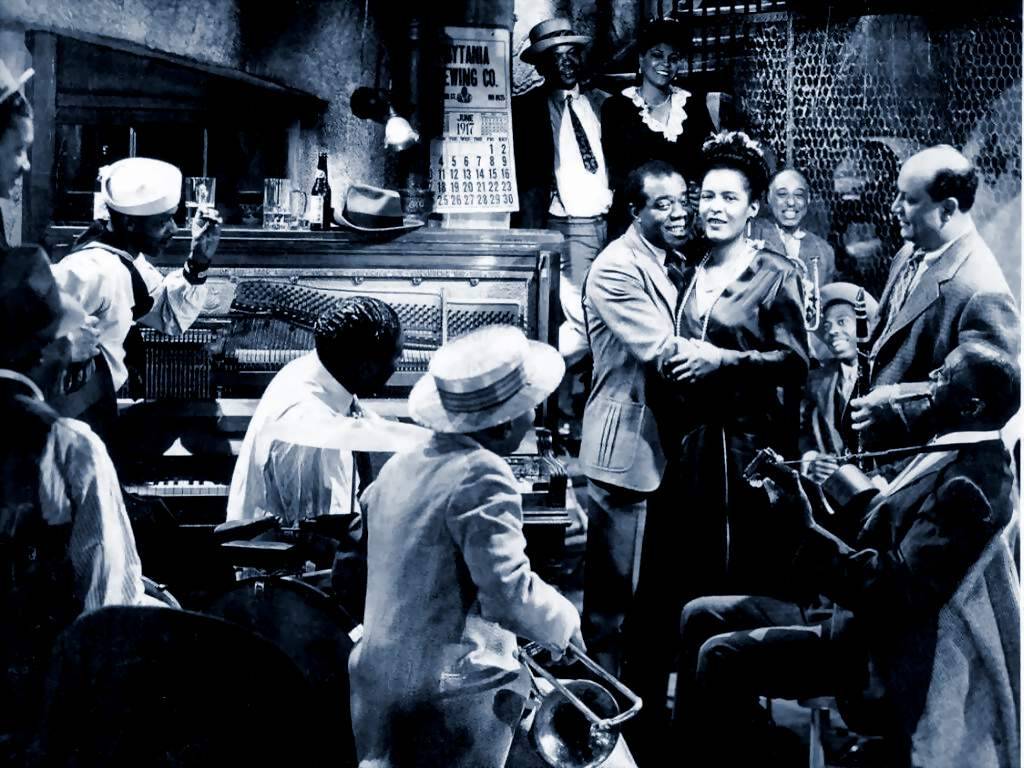
Do you know what it means to miss New Orleans
And miss it each night and day?
I know I'm not wrong, this feeling's gettin' stronger
The longer, I stay away.
Miss them moss covered vines, the tall sugar pines
Where mockin' birds used to sing,
And I'd like to see that lazy Mississippi, hurryin'
into spring.
The moonlight on the bayou, a Creole tune that
fills the air.
I dream about magnolias in bloom and I'm wishin' I
was there.
Do you know what it means to miss New Orleans
When that's where you left your heart?
And there's one thing more, I miss the one I care
for
Louis Armstrong and Billie Holiday
(1946)
More than I miss New Orleans.
by Denise Harrigan
I’d never taken the term ‘field trip” literally until I found myself in a lush pasture outside Parma, Italy, surveying the cows that supply the milk for Parmigiano-Reggiano cheese. As part of an Italian cuisine-and-culture course at Academia Barilla (www.academiabarilla.com), we took daily field trips from Parma into the fertile plains of the Po River Valley. On a crystal clear June morning, we were following the trail of Parmigiano-Reggiano, the king of Italy’s--and arguably the world’s--cheeses.
Fresh is the mantra of Italian cuisine–simple seasonal foods are objects of worship. But the Italians also take the preservation of their bounty to new heights, as demonstrated by their incomparable cheeses, olive oils, cured meats and condiments. As students at the Academia we devoted part of each day to tracing these products. I came to regard the daily excursions as audiences with the alchemists of Italy – artisans who worked sublime magic with the most mundane ingredients.
The global popularity of such high-profile products, including Prosciutto de Parma and traditional balsamic vinegar, ironically heightens the challenge to maintain standards. Admiration and demand leads to duplication, which leads to dilution. As with counterfeit Louis Vuitton handbags, there is always the fear that inferior reproductions will tarnish the image of the original product. In addition to teaching professional and amateur chefs, the young company seeks the best of these traditional products and markets them, in small batches, under the Academia Barilla label.
So, early that morning we traveled to the hillside Caseilficio Ferrarini in Castella to witness the first stage of Parmigiano-Reggiano cheese, the blending of the fresh morning milk with the milk of the previous evening, which is then boiled, skimmed, and curdled in small batches. Poured into wheels the size of small tires, the cheese would later be soaked in salt water then aged for up to two years, or until it develops its characteristic bite and crystalline texture. A consortium controls every aspect of production, including the time of release for sale. A wheel that sounds hollow when tapped by a consortium inspector, or a morsel that tastes an iota less than perfect, is branded with an X and cannot be sold as authentic Parmigiano-Reggiano.
But the two-year-old King of Cheeses is a mere toddler compared to the exalted traditional balsamic vinegar of Modena. Our search for its source took us to Acetaia Galletti, an elegant, magnolia-shaded villa in Modena.
For hundreds of years the families of Modena have nurtured their private stores of vinegar, using sets of 10 graduated wooden barrels, passed down to the oldest daughter in the family. Each barrel is made from a different wood – cherry, chestnut, oak, mulberry, juniper – and each wood whispers softly to the maturing vinegar. Once a year, over 12 or 25 years, half the liquid from one barrel is tenderly transferred into the next smaller barrel. “It’s not a big work,” the owner confided. “The most important thing is the time.”
At a cost of about $150 for only five ounces of 12-year vinegar, and $250 for 25-year vinegar, this is a very distant cousin to the mass–produced, caramelized balsamic vinegar we casually splash into salads. Traditional balsamic vinegar, each batch approved by the local consortium, is reverently dribbled into tiny ceramic spoons (right) and savored like fine wine for its slow release of complex flavors.
At Prosciuttoficio San Pietro in Parma we witnessed once again the alchemy of rural Italy: the simplest ingredients –in this case, salt and a pork leg--transformed by time, moderate temperatures, and the the soft, dry breezes of the Po River Valley (they open the factory windows at night)--into the sweet, dense ham known worldwide as Prosciutto di Parma.
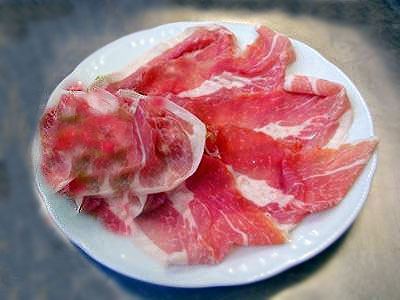 San Pietro is a major player in this
region, producing 400,000 prosciutti
per year, yet its
staff beamed with pride as they sliced their ham into paper-thin
wisps (left), twirled them
around a breadstick and offered their treasure,
with a glass of Malvasia dell'Emila to our appreciative party.
San Pietro is a major player in this
region, producing 400,000 prosciutti
per year, yet its
staff beamed with pride as they sliced their ham into paper-thin
wisps (left), twirled them
around a breadstick and offered their treasure,
with a glass of Malvasia dell'Emila to our appreciative party.The local terroir plays an inextricable role in the production of such products, and imitators elsewhere could easily sully their reputation. But the Italians are generous souls, and at Academia Barilla they are still delighted to share many of their culinary “secrets”--especially the interrelationship of time and food.
It seems the antithesis of our American approach to meals. We pride ourselves on multitasking–eating in front of the computer or television, grocery shopping while we talk on the cell phone, drinking coffee while we drive to work, reading the newspaper during dinner. Not so in Italy, or at least in Parma, where they savor every meal and linger at the table for as long as possible. It is part of something too many of us have lost--civilization.
The most important lessons I brought home were lessons about life, taught most memorably by the youthful staff at the Academy. For example, Executive Chef Nicola Bindini, who orchestrates grand feasts for hundred of guests, hummed contentedly as he taught us to turn flour and water into silky strands, curls, tubes and pillows of pasta. Lesson learned? It’s about the process as much as the final product.
We were also tutored--unwittingly--by Francesca and Rosangela,
Both young women ride bikes to work, the traditional mode of transportation in Parma. If Francesca and Rosangela couldn’t get home for lunch, they would eat in the canteen at the office, where they would discuss families, food, films, politics, but never business. It would be unthinkable for them to eat a panino in front of the computer or to walk around with a bag of chips or coffee in a styrofoam cup. On the way home from work, they shopped for dinner, even if they were dining solo.
When they talked about food, they smiled. Both are slender and very chic–evidence of Parma’s reputation as the most stylish city in Italy. They ate with gusto but in moderation, consuming (I suspect) more salad than pasta. They didn’t eat standing up or between meals. Or behind the wheel.
I suspect that these young professionals have fewer possessions and simpler needs than their American counterparts. I noticed they crammed fewer commitments into each day and graciously accommodated interruptions and delays. Perhaps the tidal wave of global commerce will soon force them to work more and linger less at the dinner table, with family and friends. (Certainly Italy’s much-protested adoption of the Euro is prompting many once-comfortable citizens to cry poverty.) But for now these young ambassadors are biding their time and still savoring life. We have much to learn from their simple example.
NEW YORK CORNER: A City for Big Eaters of Every Kind
by John Mariani
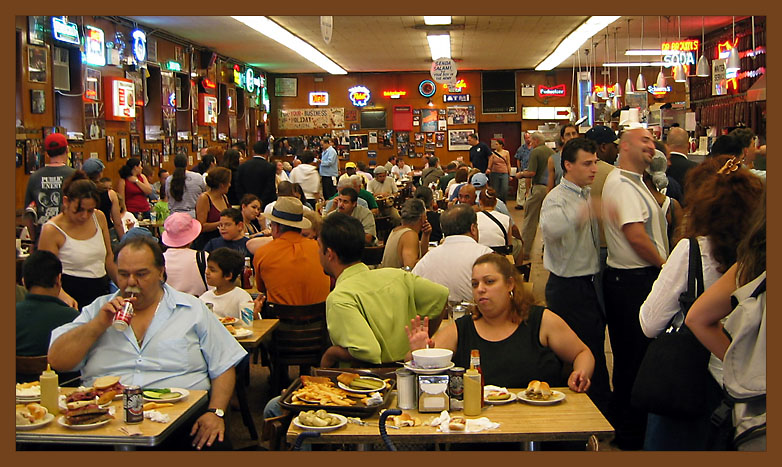
KATZ'S DELICATESSEN, Houston & Orchard Streets Photo: Oliver Springauf
The latest--and lamest--brickbat thrown at the city come in the form of a weird article in the August GQ entitled "The 4 Best Cities on Earth (to Eat In)," which, according to various writers for the magazine, would be Bangkok, Los Angeles, Madrid, and Piedmont (which, of course, is a region of Italy, not a city). Kudos are also lavished upon Melbourne and De Valls Bluff--called "the Paris of Arkansas."
Clearly urged to be churlish, the authors (one described as "a senior forensic pathologist in the Office of the Chief Medical Examiner in New York") huff and puff a bit too much, but I won't bother to argue with them about their choices, odd as some may seem (Madrid?). I will, however, take issue with ridiculous anti-NYC statements to the effect that "when it comes to food, Los Angeles makes Paris look one-dimensional, London pathetically limited, and New York not only horribly expensive but absurdly pretentious," (Mark Bittman). Another (Adam Rappaport) whines though the cliché that NYC has lost its game when it comes to good pizza, bagels, and pastrami.
The authors are far more enthralled by Korean lunch counters in L.A. and a place where the pies are made in an old bike-repair shop (I kid you not), exhibiting a retro-snobbery about any restaurant that would--gasp!--dare charge more than $50 for a meal.
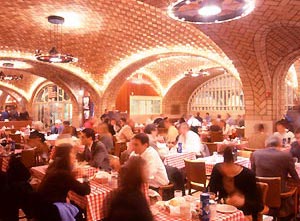
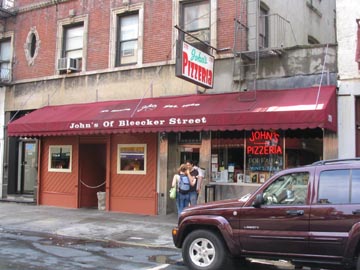 In answer to such silly assertions, I might
simply
direct you to a delightful article by Jane and Michael Stern in the
August issue of Sky Magazine (click here), entitled
"Noshville Is Another Name for Manhattan," in which they write, "The
gastronomic landscape [of NYC] ranges from avant-garde meals cooked by
Four Star chefs to street-corner hot dogs smothered in stewed onions,"
proceeding to list 15 of their favorites, including Katz's
Delicatessen, The Oyster Bar at
Grand Central (above),
Sarabeth's Kitchen, John's of Bleecker Street Pizzeria (above), Faicco's Pork Store (below, right), and
others.
In answer to such silly assertions, I might
simply
direct you to a delightful article by Jane and Michael Stern in the
August issue of Sky Magazine (click here), entitled
"Noshville Is Another Name for Manhattan," in which they write, "The
gastronomic landscape [of NYC] ranges from avant-garde meals cooked by
Four Star chefs to street-corner hot dogs smothered in stewed onions,"
proceeding to list 15 of their favorites, including Katz's
Delicatessen, The Oyster Bar at
Grand Central (above),
Sarabeth's Kitchen, John's of Bleecker Street Pizzeria (above), Faicco's Pork Store (below, right), and
others.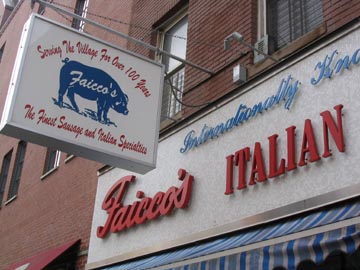 The list could easily have run into the hundreds.
I could add a few score myself off the top of my head.
The list could easily have run into the hundreds.
I could add a few score myself off the top of my head.One has to wonder if the GQ writers have actually ever eaten at such places in NYC or ever wandered out to Astoria, Queens, for Greek, Albanian, or Thai food. Have they ever tasted the array of regional foods in the neighborhood called "Little Delhi"? Have they ever set foot in any of the Russian restaurants in Brighton Beach, Brooklyn, or savored the Italian food on Arthur Avenue in the Bronx? Are they even aware that NYC has a vast Chinatown, which now includes as many Vietnamese restaurants as it does Canton-style eateries. Have they ever picked up a copy of Village Voice writer Robert Sietsema's The Food Lover's Guide to the Best Ethnic Eating in New York City, which lists everything from a Guatemalan restaurant in Jamaica and a South African restaurant in Brooklyn to a Tibetan restaurant on Amsterdam Avenue and a Surinamese bakery on Woodhaven Boulevard?
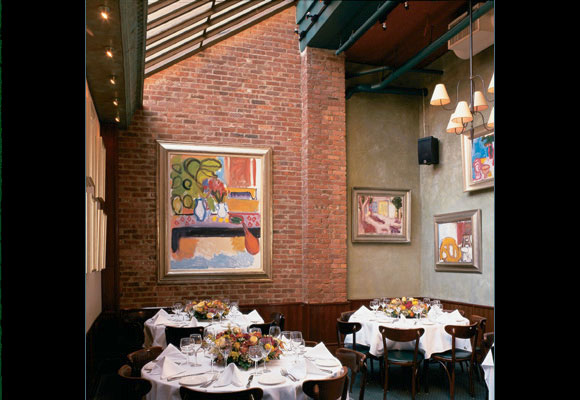 As for those high-end restaurants that seem to horrify
the GQ cult, the simple
response is, "So don't go to them," even if you'll miss some of the
best food, design, and service on earth. The other night, walking
along two square blocks of TriBeCa, I passed restaurants that any city
on earth would kill to have--Montrachet, TriBeCa Grill (left), Centrico (reviewed below), Bouley, Danube,
Chanterelle, Danube, Nobu, Landmarc, Odeon, Pace, Scalini Fedeli, and
Harrison. Here they were all within footsteps of one another, and
the most expensive of them--Bouley--charges $85 for an 8-course tasting
menu--a bit more than they charge for the bike shop pie,
but definitely a whole lot more interesting.
As for those high-end restaurants that seem to horrify
the GQ cult, the simple
response is, "So don't go to them," even if you'll miss some of the
best food, design, and service on earth. The other night, walking
along two square blocks of TriBeCa, I passed restaurants that any city
on earth would kill to have--Montrachet, TriBeCa Grill (left), Centrico (reviewed below), Bouley, Danube,
Chanterelle, Danube, Nobu, Landmarc, Odeon, Pace, Scalini Fedeli, and
Harrison. Here they were all within footsteps of one another, and
the most expensive of them--Bouley--charges $85 for an 8-course tasting
menu--a bit more than they charge for the bike shop pie,
but definitely a whole lot more interesting.New York bashing is fun--and New Yorkers do it all the time. And New York restaurants can be as awful as anywhere in the world. But substituting the charms of the fried bologna sandwich at the Allen Street Bar & Grill in Buffalo or the char dog at Weiner's Circle in Chicago, described in the GQ article as "dishes worth traveling for," is no substitute for substantive criticism.
New York author Calvin Trillin once wrote about remembering a great restaurant in Chinatown he and his wife Alice hadn't been to in years. "This is why we live here," he said to Alice. "Where else could you forget a restaurant like this?"
[Letters to the editor--that would be me--graciously accepted for response.--John Mariani]
CENTRICO
211 West Broadway
212-431-0700
Do
good cooks run in the
family?
I suspect so, if Aaron
Sánchez (below, right)
and his
sister Marissa are any indication. They
are the children of the redoubtable restaurateur and
prolific food author Zarela Martínez, and they've followed in
her
footsteps with the same admirable dedication to Hispanic food culture.
Marissa stays close to Zarela's namesake restaurant, while Aaron,
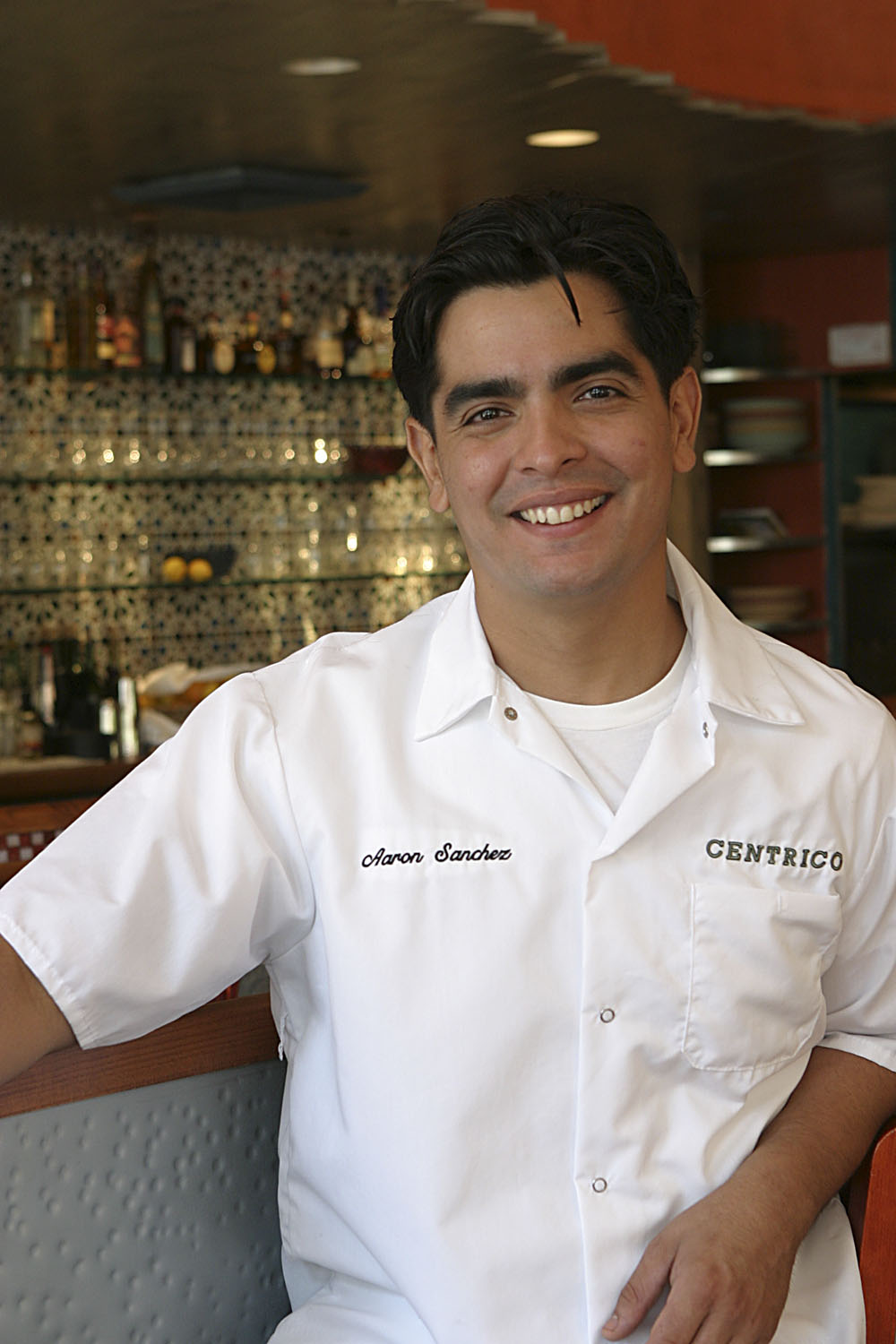 co-host of the show
"Melting Pot" on the Food Network, worked has at Patria
in NYC, then with Reed Hearon at Rose Pistola in San Francisco,
returning to
NYC to cook at Isla before opening Paladar on the Lower East
Side. He was also chef at Mixx in Atlantic City.
co-host of the show
"Melting Pot" on the Food Network, worked has at Patria
in NYC, then with Reed Hearon at Rose Pistola in San Francisco,
returning to
NYC to cook at Isla before opening Paladar on the Lower East
Side. He was also chef at Mixx in Atlantic City.
Now Drew Nieporent, of Myriad
Restaurant Group, has lured him to be chef at Centrico, which replaces
Myriad's long-running Middle Eastern restaurant Layla, so a lot of the
former's Arabian nights decor has been finessed into something a bit
more
Chihuahuan. On a good night you can sit outside and watch TriBeCa come
and go at a pace far more leisurely than anywhere else in the city.
Order one of the house's special margaritas--passion fruit, blood
orange, and so on--and tackle the chips with a choice of salsas, and
you're already on your way to feeling pretty smooth.
The one-page menu has enough
appetizers to feast from the left-hand side. Picadas are yummy
little corn tarts with avocado tomatillo salsa, roasted tomato salsa,
and tangy queso fresco,
and there's a fine quesadilla of vegetables and queso Oaxaca, with roasted
tomatillo sauce. Seared rare tuna comes with the welcome textures
of mango and jicama salad with watermelon salsa, and by all
means order
a sampling platter of the bright, brisk ceviches here (left) with attendant
citrus juices.
Still among the entradas
are pan-seared scallops with a lovely pea purée and citrus
salsa, and meaty frogs' legs with a salsa
verde and calabacitas con
queso. All these run a mere $7-$9.
The main courses are hefty, with nothing over
$22, and the slow-roasted suckling pig with achiote, garlic, and bitter
orange (right), at $17, has
got to be one of the best bargains in the
city. So, too, the juicy, deeply flavorful braised short ribs
Jalisco style in an ancho chile broth, at $19, shows the kind of
largesse Centrico is all about. Fluke was breaded with seasoned
flour and lightly sautéed, served with a grilled tomato salad
($17), and the grilled chicken with roasted garlic, lime and chipotle
had all the elements to enhance without distracting from the good taste
of the chicken itself.
Postres
(desserts, all $6) include pineapple with pink guava
salsa, a taco with cacao beans, roasted mango and apricot, and a spicy
mango sorbet, and a terrific molten Mexican chocolate cake with helado de maiz. Dulce de leche cake was far less
rich than it usually is, and I missed that.
The wine list is brief, the big reds well
chosen to go with this food--though beer would do nicely too--and there
are plenty of labels under $35 to choose from that will not be wiped
out by the chile, hot, and sweet flavors of the cooking here.
TRAVEL ARTICLES WE NEVER FINISHED READING.
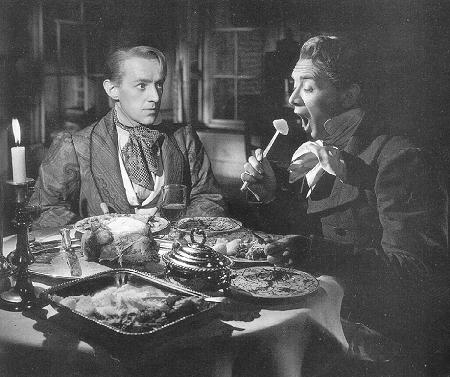
"You would never guess that Lake Austin Spa resort is the brainchild of two former fraternity brothers going through mid-life crisis."--Samantha Brooks, "Lone Star Spa," The Robb Report Collection (May 2005).
HAVE A SEAT
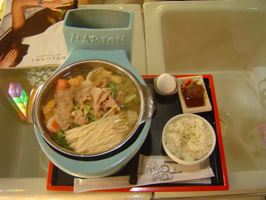
* On Sept. 16 in Louisville, KY, Chef Joe Castro of The English Grill at The Brown Hotel has announced the line-up of bacon producers and chefs to participate in the 7-course Camp Bacon Dinner, incl. Jared Richardson of Wallace Station; Ouita Michel of the Holly Hill Inn; Jim Gerhardt of Limestone Restaurant; John Castro of Winston’s at Sullivan U.;
* On Sept. 21 Chef/Owner Evan Kleiman of
* The Inn at Danbury in
~~~~~~~~~~~~~~~~~~~~~~~~~~~~~~~~~~~~~~~~~~~~~~~~~~~~~~~~~~~~~~~~~~~~~~~~~
MARIANI'S VIRTUAL GOURMET NEWSLETTER is published weekly. Editor/Publisher:
John Mariani. Contributing Writers: Robert Mariani, Naomi
Kooker, Kirsten Skogerson, Edward Brivio, Mort
Hochstein, Lucy Gordan, Suzanne Wright. Contributing
Photographers: Galina Stepanoff-Dargery, Bobby Pirillo. Technical
Advisor: Gerry McLoughlin.
Any of John Mariani's books below
may be ordered from amazon.com by clicking on the cover image.
 |
 |
 |
 |
 |
 |
copyright John Mariani 2005